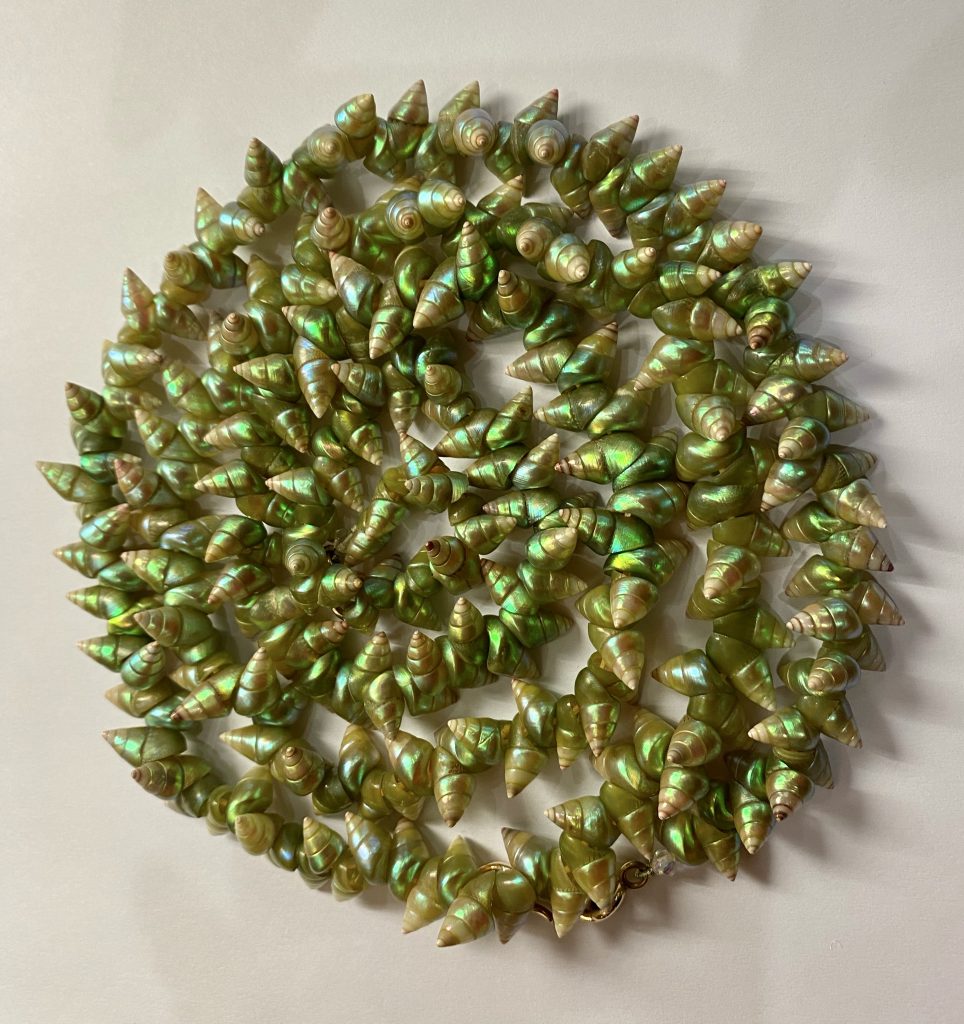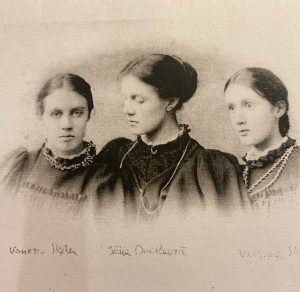
Above: Exquisite and lustrous Tasmanian shell necklace.
A visit to the Tasmanian Museum and Art Gallery (TMAG) Exhibition, ‘Return to Country’ (Taypanimilaything-tu) renewed my interest in these beautiful and rare items, an interest which began in 2007 with my exhibition at ASA of 30 Antique and Contemporary Aboriginal shell necklaces, and later in 2014 at Object Gallery Sydney –‘Lola Greeno: Cultural Jewels’.
Lola Greeno is recognised as the matriarch of the revival of the art of making shell necklaces.
TMAG’s Exhibition RETURN TO COUNTRY showed aboriginal artefacts which had been collected by early explorers and colonials and taken back to England and Europe as souvenirs. The TMAG curators had requested their return for this special exhibition and are hoping to negotiate a future permanent return to country. I was particularly impressed by the lovely shell necklaces held by the British Museum and the Victoria & Albert Museum London, and the National Museums Scotland, which are in perfect condition after 200 years! I have since learned that 13 Tasmanian shell necklaces were exhibited at the Great Exhibition held in London 1851 at the Crystal Palace.
The stories behind the tradition of making shell necklaces fascinates me. It is a long and arduous process and requires great patience, knowledge and skill, which is being passed down from mothers to daughters in families from the Furneaux Islands in Bass Strait (Flinders and Cape Barren).
Lola Green states in her book ‘Cultural Jewels’ – “Living shell collection requires arduous cleaning processes, sometimes taking months to remove the animal, and with maireeners there is the additional, secret means of removing the outer surface to reveal the inner, magically opalescent sub-surface of the shell, the gem within.”
This necklace work involves four separate processes
1 – collecting the specific shells at certain times of the year, with certain tides and climatic conditions
2 – cleaning to remove the outer layer to expose the brilliant colours of the shells. In former times this would be done by burning grass over wood embers when the action of the pyroligneous acid removed the outer coating from the shell, but today they are cleaned with a diluted chemical solution.
3 – piercing the shells
Originally the women punctured the shells using the eye tooth of a wallaby, and threaded them with kangaroo sinew or plant fibre
4 – Ordering and stringing the shells – Today they use nylon or fine wire.
Finally, as Julie Gough says in the catalogue of the 2016 TMAG exhibition Kanalaritja – An Unbroken String “Tasmanian Aboriginal shell work is unique, the patterns and shell types indicate the maker and also reflect a place or places, the seashores from whence they came, and the knowledge of collecting and making. These necklaces offer insight into how to do things the right way, in slow time, with care. This is a gift not only for the makers, but to those who hold them. Those wearing them are our cultural ambassadors. They reveal by carrying our culture in this way their respect for our people, and for our Ancestors who ensured our survival and of cultural practices, including shell stringing”
Virginia Woolf and Vanessa Bells’ Tasmanian shell necklaces
A recent article in the magazine ‘The World of Interiors’ dated January 2024 alerted me to an exhibition ‘Bring No Clothes : Bloomsbury and Fashion’ at Charleston in Lewes, U.K., in which is displayed an 1896 photo of Virginia Woolf with her sister Vanessa on either side of their half-sister Stella Duckworth, wearing Tasmanian maireener shell necklaces – one is blue and green, the other pink and taupe. The actual necklaces are displayed with the photo. Apparently the necklaces came down through the family and are featured on the cover of Virginia Woolf’s Diaries, edited by Vanessa’s daughter-in – law, Anne Olivier Bell.

The writer of this article Lauren Elkin, finds herself “incredibly moved: closer to Virginia and Vanessa than I have ever come……… whatever visceral quality the photograph possessed was reinforced by the presence of the actual necklaces……. so that in the image of the three women, I must now imagine a shadowy fourth, the one who strung the shells on to the sinew, never knowing they would decorate the neck of a motherless young lady who understood the mystery, power and energy concentrated in these solid objects”
Anne Schofield, A.M.

Recent Comments